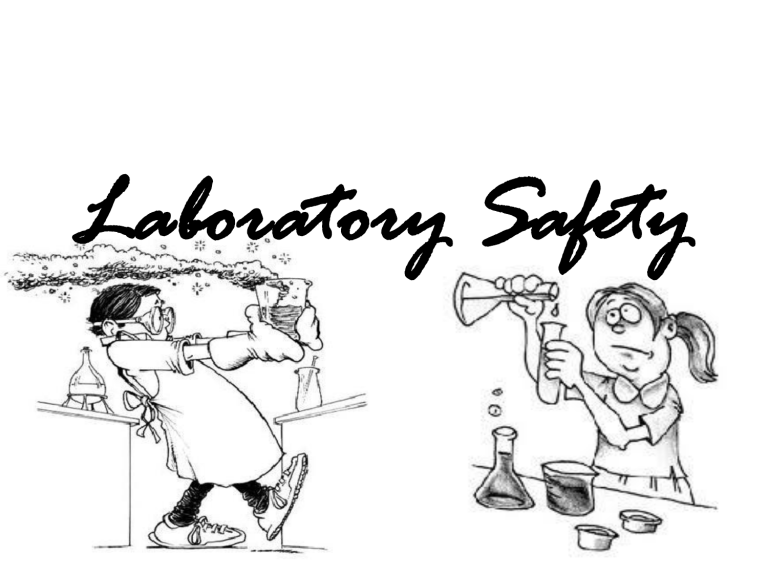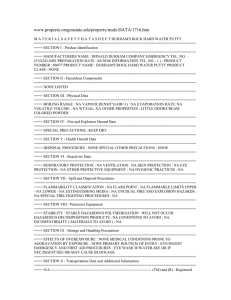
Laboratory Safety CHEMICAL SAFETY . • In 1987, United States Occupational Safety and Health Administration (OSHA) published the Hazard Communication Standard providing institutional educational practices to ensure all laboratory personnel have a thorough working knowledge of the hazards of chemicals with which they work. • Called “Right-to-Know”, which mandates that all hazardous chemicals in the workplace be identified and clearly marked with National Fire Protection Association (NFPA) label, stating the health risks and the hazard class. NFPA Label • Chemical hygiene plan – includes guidelines on proper labeling of chemical containers, manufacturer’s material safety data sheet (MSDS), and the written chemical safety training and retraining programs Employer’s Responsibility: 1. establish laboratory work methods and safety policy 2. provide supervision and guidance to employees 3. provide safety information, training, PPE, and medical surveillance to employees 4. provide and maintain equipment and laboratory facilities that are adequate for the tasks required Employee’s Responsibility: 1. know and comply with the established laboratory work methods 2. have a positive attitude toward supervisors, coworkers, facilities, and training 3. give prompt notification of unsafe conditions to the immediate supervisor 4. engage in the conduct of safe work practices and use of PPE Material Safety Data Sheet includes: 1. 2. 3. 4. 5. 6. 7. 8. 9. 10. 11. 12. Substance name Name, address, and telephone number of manufacturer Hazardous ingredients Physical and chemical properties Fire and explosion data Toxicity Health effects and first aid Stability and reactivity Shipping data Spill, leak, and disposal procedures PPE Handling and storage Safety Equipment: 1. safety showers deliver 30-50gal/min of water at 2050psi 2. eye-wash stations 3. fire extinguishers 4. fire blankets, spill kits, first aid supplies 5. mechanical pipetting must be used for manipulating all types of liquids 6. hoods ▪ fume hoods – required to expel noxious and hazardous fumes ▪ biosafety cabinet – remove particles that may be harmful to the employee who is working with infective biologic specimens with biosafety levels Chemical Storage Equipment 1. safety carriers should always be used to transport 500mL bottles of acids, alkalis, or other solvents 2. approved safety cans should be used for storing, dispensing, or disposing flammables in volume greater than 1qt 3. safety cabinets are required for the storage of flammable liquids 4. only specially designed explosion proof refrigerators should be used to store flammable materials 5. gas cylinders supports or clamps be used at all times, and large tanks should be supported using handcarts Chemical Spill (C-L-E-A-N) • Contain the spill • Leave the area • Emergency: eye wash, shower and medical care • Access MSDS • Notify supervisor FIRE SAFETY . • Considered an important component of the laboratory safety program. • Each laboratory is required to post fire evacuation plan that are essentially blue prints for finding the nearest fire exit in case of fire. • Fire drills should be conducted quarterly or annually depending on local laws to ensure that all personnel know what to do in case of fire. • Exit ways should always remain clear of obstructions, and employees should be trained to use fire extinguishers. Actions in case of fire: (R-A-C-E) 1. Rescue any injured individuals 2. Activate the fire alarm 3. Contain the fire; close the doors 4. Extinguish the fire, if possible Classification of Fire Types of Fire Extinguishers ELECTRICAL SAFETY . • Electrical cords should be checked regularly for fraying and replace when necessary. • All plugs should be the three-prong, grounded type. • All sockets should be checked for electrical grounding and leakage at least annually. • No extension cords should be used in the laboratory. HANDLING OF COMPRESSED GASES 1. Compressed gas cylinders contain pressurized gases and must be properly handled and secured. 2. In cases where leaking cylinders have fallen, tanks have become missiles, resulting in loss of life and destruction of property. 3. The metal cap should always be in place when gas cylinder is not in use. 4. Cylinders should be transported chained to special dollies. BIOSAFETY . General Considerations: a. All blood samples, and other body fluids should be collected, transported, handled, and processed using strict precautions. b. Gloves, gowns, and face protection must be used if splash or splattering is likely to occur. c. Centrifugation of biologic specimens produce finely dispersed aerosols that are high-risk source of infection. Ways to acquire laboratory infections: 1. rubbing the eyes or nose with contaminated hands 2. inhaling aerosols produced during centrifugation, vortexing, or spills 3. accidental ingestion of microorganisms 4. suffering percutaneous inoculation by needlestick RADIATION SAFETY . 1. Dispose all radioactive material in appropriate labeled container 2. Report any exposure to radioactive material and seek medical attention 3. Radiation monitoring: – film badge or survey meter – exposure limits (max. permissible dose: 5000mrem/yr) – wipe test (leak test) EXPOSURE CONTROL PLAN Plan identifies tasks that are hazardous to employees and promotes employee safety through: a. employee orientation and education b. appropriate disposal of hazardous wastes c. standard precautions d. engineering controls and safe work practices e. PPE f. postexposure plan Types of Wastes 1. Hazardous Waste – solid waste or mixture of solid wastes which may pose a threat to human health or the environment when improperly handled 2. Infectious Waste – equipment, utensils, or substances that may harbor or transmit pathogenic organisms from individuals who may have a communicable disease 3. Medical Waste – any solid, semi-solid or liquid waste generated in diagnosis, treatment or immunization of humans or animals in research or production or testing of biologics DISPOSAL OF HAZARDOUS WASTES • All materials contaminated with potentially infectious agents must be decontaminated before disposal. • Infectious waste may be decontaminated by use of autoclave, incinerator, or any one of several alternative waste-treatment methods • Infectious waste should be placed into two leak-proof, plastic bags for sturdiness (doublebagging) • Pipettes, swabs, and other glass objects should be placed into rigid cardboard containers before disposal. • Broken glass is placed in thick boxes lined with plastic biohazard bags • Sharp objects are placed in Sharps Containers which are autoclaved or incinerated when full STANDARD PRECAUTIONS . • In 1987, published and was first known as Universal Precautions. Aimed at reducing the risk of HBV transmission in clinical laboratories and blood banks. In 1996, became Standard Precautions and postulates that: 1. Do not eat, drink, smoke, or apply cosmetics (including lip balm). 2. Do not insert or remove contact lenses. 3. Do not bite nails or chew on pens. 4. Do not mouth-pipette. 5. Limit access to the laboratory to trained personnel only. 6. Assume all patients are infectious. 7. Use appropriate barrier precautions to prevent skin and mucous membrane exposure. 8. Thoroughly wash hands and other skin surfaces after gloves are removed and immediately after contamination. 9. Take special care to avoid injuries with sharp objects. THE END!


